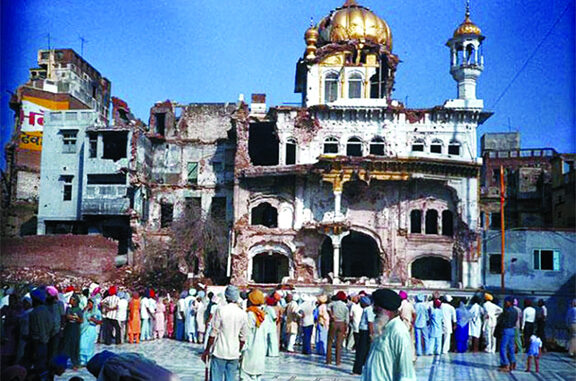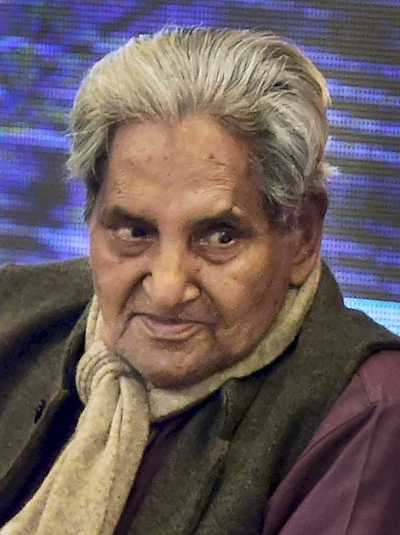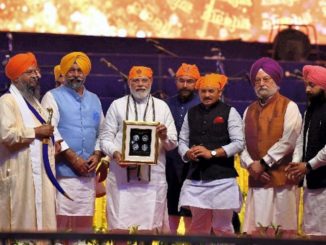
38 years after it took place, the infamous Operation Blue Star is a festering wound for the Sikh community the world over whose psyche was terribly hurt to find their Holiest Shrine desecrated, the Holy Akal Takht — sign of the Sikh dignity-raged to the ground, and thousands of innocent pilgrims killed , all in the name of neutralizing “Sikh extremists/ militants” led by Sant Jarnail Singh Bhindranwale. Hundreds of books and thousands of articles have been published on the issue, and the authors have analyzed the causes and the effects, and, of course, their views on the issue diverged, but almost all have questioned the need and wisdom to have a military operation to “neutralize the Sikh extremists / militants”. Just as the Jews have not forgotten the Holocaust, the Operation Blue Star will continue to be a festering wound for the Sikh community.
It happened 38 years ago but it feels as if it was yesterday – the heart, body and mind still feel the tremors of the emotional earthquake it caused. The force of those tremors intensifies every year when June 6 approaches. Operation Bluestar (saka neela tara), a fancy-sounding name given to a dreadful military action at the Sikhs’ holiest shrine, the Golden Temple in Amritsar, was launched on June 2, 1984, with a ‘national broadcast to the nation’ by then prime minister Indira Gandhi. It was claimed to have been completed successfully on June 6 with the ending of the last resistance by Sikh combatants to the army’s entry at the Temple. State media (TV and radio) and other non-state media outlets praised the operation for saving India’s ‘unity and integrity’ from ‘anti-national’ Sikh secessionism.
The most reliable estimates of the total number of deaths during Operation Bluestar range from 5,000 to 7,000. It was a tragedy that could have been avoided if – and it is a big if – Indira Gandhi had had the vision to reach a political settlement with the moderate Akali leadership. Most Akali Dal demands – regarding federal decentralisation, river water rights, territorial readjustment and the transfer of Chandigarh to Punjab as its capital – could have been negotiated. Rajiv Gandhi did agree to each of these demands, and many more besides, in the 1985 Rajiv-Longowal Accord. He implemented none.
Indira Gandhi’s political decision to use the ‘Hindu card’ to gain electoral victories led her to choose a dangerous path of confrontation, first with the Akalis and eventually with the entire Sikh community. This miscalculation cost Mrs Gandhi her life, and left the communities of Punjab and of India in general scarred and polarised. This polarisation peaked with the genocidal violence against the Sikh minority in Delhi and many other North Indian Hindu majority towns in November 1984 after the assassination of Indira Gandhi by two of her Sikh security guards. Sikh nationalists in Punjab were eventually defeated, at least militarily, by the 1990s, but Hindu nationalism was promoted so powerfully that the Hindu nationalists succeeded within a few decades in capturing the Indian state.
In the Sikhs’ collective memory of 1984, the deaths by army action in June and those by genocidal mob violence in November constitute two ends of the same arc of killings. The two cannot be separated and, therefore, remain indelibly linked to the memory of Operation Bluestar, which is seen as the trigger both for the killings and for later disappearances, killings in custody and deaths by ‘encounters’ during the military operations against the armed Sikh opposition movement after the events of 1984.
Operation Bluestar is gradually finding a place in the Sikh practice of ardaas (prayer). This practice is unique in the history of world religions because it gives collective memory a central place. On all important occasions – birth, marriage, death, new job, promotion, passing an examination, new house, Gurpurab celebrations (in honour of the gurus’ birthdays), or even the daily rituals in a gurdwara – the ardaas recounts in capsule form the history of the Sikh faith.
The ardaas narrative starts with the founding of the faith by Guru Nanak, its continuation by his nine successors and the sacrifices made by the tenth guru Guru Gobind Singh’s four sons (sahibzade), the five Beloved Ones (panj piare), the 40 Liberated Ones (chali mukte) and numerous other martyrs right up to the present time. Sikhs have a long memory. Udham Singh waited for 21 years to avenge the Jallianwala Bagh massacre of 1919 by assassinating Michael O’Dwyer in 1940. The Naxalite Sikhs punished a Sikh landlord Ajaib Singh Kokri, a witness against the revolutionary Bhagat Singh, by assassinating him in 1974, 43 years after Bhagat Singh was hanged in 1931. The socialisation from early childhood of anyone growing up in a Sikh household (irrespective of the political affiliation of the household) involves such a focused exercise in historical remembrance that most adult Sikhs remember the ardaas by heart, whether they are illiterate farmers or university academics. The ardaas contributes to the making of an active historical being who remembers the past, relates that past to the present and imagines the shaping of the future.
Blue Star bloodbath
Shortly after 10.30 p.m. on June 5, 1984, 20 men in black dungarees stealthily entered the Golden Temple. They wore night-vision goggles, M-1 steel helmets, bulletproof vests and carried a mix of MP-5 submachine guns and AK-47 assault rifles. The men of sg’s 56th Commando Company were then the only force in India trained for room intervention, the specialised art of fighting in confined spaces. Each commando was a sharpshooter, diver and parachutist and could do 40-km speed marches. Some of them wore gas masks and carried stubby gas guns meant to launch CX gas canisters, a more potent tear gas. Three months before this night, the commandos had stayed around the temple and rehearsed for Operation Sundown. Some of them still sported the beards they had grown for their undercover work as volunteers in the Golden Temple’s langar. When the plan was called off, they returned to their base in Sarsawa. They had flown into Amritsar the previous day at the request of Lt-Gen Sundarji.
The three battalions that Lt-Gen Brar’s 9th Infantry Division sent into the Golden Temple that night were trained to fight a conventional combat on the plains of Punjab and in the deserts of Rajasthan. They would overwhelm the enemy by sheer force of numbers. The commandos, who spearheaded the assault, made use of stealth, speed and surprise to achieve results. Soon after arriving, one of the sg officers had briefed Lt-Gen Ranjit Singh Dayal, Sundarji’s chief of staff, on a plan to capture the Akal Takht by blowing off its rear wall. General Dayal, a paratrooper who had captured the Haji Pir pass in an unconventional operation in the 1965 war, immediately overruled it. “There must be no damage to the Akal Takht,” he said. The commandos were to capture the sacred building by using gas to flush out the militants, he said.
The Army had clearly underestimated the defences. As soon as they entered the temple, a sniper shot the unit’s radio operator clean through his helmet. The rest took cover in the long gallery of pillars that led to the Akal Takht. Light machine guns and carbines crackled from behind impregnable walls of the temple, their multiple gun flashes blinding the commandos’ night-vision devices, forcing them to take them off. The commandos and infantry soldiers cautiously advanced, sheltering behind rows of pillars. Those who tried to advance towards the Akal Takht were cut down on the marble parikrama. An armoured personnel carrier bringing in troops was immobilised by a rocket-propelled grenade. “Shabeg knew the Army’s Achilles heel,” says an SG colonel. “He knew we couldn’t fight in built-up areas.”
Post-midnight, remnants of the sg unit and the Army’s 1 Para huddled near a fountain at the base of the Akal Takht. The area between the Akal Takht and the Darshani Deori that led to the Golden Temple had turned into a killing zone, covered by Shabeg’s light machine guns. Attempts by the para-commandos to storm the defences were repeatedly beaten back. They lost at least 17 men, their black dungaree-clad bodies lying prone on white marble. Commandos who tried to fire the CX gas canisters discovered that the Akal Takht’s windows had been bricked up. The only openings were horizontal slots out of which machine guns poured deadly fire. The commandos neutralised two of the machine gun nests by dropping grenades into them but the Akal Takht was impregnable. Then, around 7.30 a.m. on June 5, three Vickers-Vijayanta tanks were deployed. They fired 105 mm shells and knocked down the walls of the Akal Takht. Commandos and infantrymen then moved in to mop up the defenders, tossing gas and lobbing grenades inside the building.
The temple premises resembled a medieval battlefield, one sg trooper recalls. Bloodied and blackened bodies lay scattered around the white temple parikrama. In the basement of the blackened, still-smoking ruin of the Akal Takht, the commandos found the body of Shabeg. The Army recovered 51 light machine guns, 31 of which had been concentrated around the Akal Takht. “Normally, an army unit (of around 800 soldiers) would deploy this quantum of firepower to cover an area of about eight km,” Lt-Gen Brar recounted in his book Operation Blue Star: The True Story. Shabeg, he believed, wanted to hold out until daylight in the hope that there would be a popular uprising among the people when they get to know of the army action. The former war hero had extracted a bloody price on an army he felt had wronged him.
Operation Blue Star has come to be remembered as the teeja Ghallughara (the third holocaust). Many gurdwaras outside India and perhaps some even in India have incorporated the remembrance of the teeja Ghallughara in the ardaas. In Sikh historical memory, there have been two Ghallugharas before Operation Bluestar – the chhota Ghallughara (the small holocaust) and the wadda Ghallughara (the big holocaust). The chhota Ghallughara took place in May 1746 when, according to estimates made by the celebrated Sikh historian Professor Ganda Singh, about 10,000 Sikh men and women were killed. The wadda Ghallughara took place in February 1762 when about 30,000 Sikh men, women and children were slaughtered. According to one as yet unconfirmed estimate, about half of the total Sikh population was liquidated during the wadda Ghallughara.
These were the darkest times in the history of the Sikhs. These massacres could have demoralised them to the point of extinction, but, inspired by the memories of their gurus and martyrs, they regrouped and within a few decades of the wadda Ghallughara, emerged literally from the ashes to become the de facto rulers of Punjab in the last quarter of the 18th century. By 1799, one of them (Ranjit Singh) formalised that de facto rule to become the Maharaja of Punjab. The force of memory weighed upon him too and he ruled, therefore, in the name of the gurus. Some features of feudal degeneration which emerged during his rule were the result of his dissociation from the memory of the path of the gurus.
During the dark times the Sikh community faced from 1716, when the Sikh warrior Banda Singh Bahadur was martyred, to 1799 when Ranjit Singh came to power, Harmandar Sahib (later known more popularly as the Golden Temple) became the nerve centre for the moral, political, military, spiritual and even economic empowerment of the community. While living the life of guerrilla combatants against the Moghul powers, the leading members of the community would meet twice a year on Vaisakhi and Diwali for deliberations and collective decision-making for the future survival of the community. Once in the precincts of the Harmandar Sahib, they considered themselves protected by the Guru and had no fear of any earthly powers such as the Moghul rulers they had to confront. The mystique of the Harmandar grew and this mystique has continued and strengthened over the centuries. The Golden Temple has literally become the heart of the community.
The death, destruction and sacrilege caused during Operation Bluestar pierced the heart not only of the Sikhs but also of many Punjabi Hindus. The devastation it caused in the personal lives of so many millions has still not been fully recorded and acknowledged because the political divide over the attitudes towards Operation Bluestar has overshadowed the human stories.
A whole generation has grown up after the Operation and many in this new generation have become parents. They hear and read about the Operation and try to understand the meaning of it to reconnect to the history of their parents, their grandparents and before. Many of them are devising new tools and media to relate to that history. Of many doctoral dissertations I have evaluated as an external examiner, one by Shruti Devgun of Rutgers University, USA on ‘Re-Presenting Pasts: Sikh Diasporic and Digital Memories of 1984’ stands out for its subject and methodology. Her thesis focuses on the work of an intergenerational cohort of Sikhs in the diaspora (in the US and Canada) who are trying to piece together the fragments of painful pasts ‘to give cultural meaning and shape to broken traumatic experiences’.
Through their work, they are puncturing, and perhaps demolishing, the Indian State’s narratives of Operation Bluestar. This painful ‘memory work’ is creating new spaces for them to understand and connect with the pain of the victims of many other genocides e.g., the Jews, the Palestinians, the Armenians and the Rwandan Tutsis.
The wounds may never heal but by connecting your pain to the pain of others, the meaning and experience of pain is transformed.
Source: The Wire and India Today.
Writers: Pritam Singh and Sandeep Unnithan





Be the first to comment